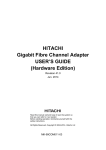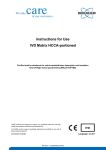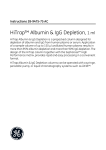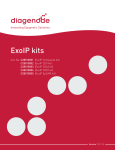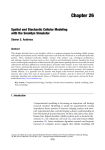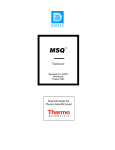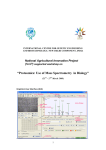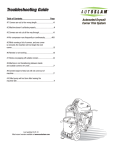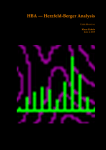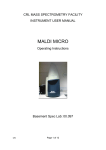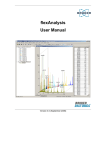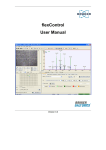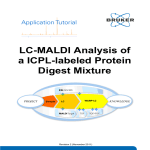Download Autoflex Basic User Manual
Transcript
Autoflex Basic User Manual Last Updated August 26, 2009 What is the Bruker Autoflex III? • Time‐of‐flight mass spectrometer – Ions of given same kinetic energy • heavy ions travel slower than lighter ones – Two modes of operation • Linear (for labile molecules or anything bigger than 5kDa) Linear (for labile molecules or anything bigger than 5kDa) • Reflectron (great for small molecules and peptides) – Capable of limited MS‐MS • Instruments in Proteomics R&D Facility are MUCH better for MS‐ MS and MSn • MALDI/LDI source MALDI/LDI source – 384 position target plate (~1 µL spot size) – 355 nm frequency tripled Nd:YAG q y p SmartBeam® laser • Can photolyze labile groups, e.g. FITC labels – Can analyze positive or negative ions (same spot) What Samples Can It Run? What Samples Can It Run? • Biopolymers – Peptides, proteins, DNA, RNA, oligosaccharides Peptides, proteins, DNA, RNA, oligosaccharides • Organometallic complexes – Organometallic salts work great • Some synthetic polymers – Polypropylene glycol, PAMAM dendrimers – Polycyclic aromatic hydrocarbons with TCNQ l l h d b h • Molecules that photoionize upon irradiation by 355 nm laser nm laser – Porphyrins – Organometallic complexes What Samples Can’tt It Run? What Samples Can It Run? • “Dirty” samples – Significant concentration of involatiles • Glycerol, urea, most buffers, many detergents – Alkali metal salts can be quite problematic • RNA/DNA analyses require extensive desalting • Molecules with significant vapor pressures – Instrument is held at ~10‐7 torr • Molecules that do not ionize in source – Lack charge acceptor/donor site Lack charge acceptor/donor site – Cannot photoionize with N2 laser General Sample Guidelines General Sample Guidelines • Purify analyte if possible – Analyte A l t should be 5 – h ld b 5 100 µM in concentration 100 M i t ti – ZipTips can purify dirty samples (C4 and C18 are in MSF) • Use only volatile solvents/buffers Use only volatile solvents/buffers – MeOH, H2O, acetone, CH3CN, THF, CH2Cl2, C6H6 – TFA, HOAc, formic acid, NH3, etc. – Ionic strength < 30 mM (e.g. 0.1% v/v HOAc) • Acidic conditions required for proper crystallization of many matrices many matrices – Lack of acidic conditions can be overcome in some cases • Need at least 2 µL Need at least 2 µL Instrument Diagram 355 nm Nd:YAG laser Target R fl t Reflectron Linear Detector Lens Extraction Plate Flight Tube Entrance Reflector Detector Linear Mode 355 nm Nd:YAG laser Target R fl t Reflectron Linear Detector Lens Extraction Plate Flight Tube Entrance Reflector Detector Linear mode is used for large ( Linear mode is used for large (>3.5 3.5 kDa) molecules or exceedingly fragile species (oligosaccharides). It is capable of 4 000 resolving power is capable of 4,000 resolving power @ 3.2 kDa (1000 RP @ 12 kDa) Reflectron Mode 355 nm Nd:YAG laser Target R fl t Reflectron Linear Detector Lens Extraction Plate Flight Tube Entrance Reflector Detector Reflectron mode is used for small species (<3.5 kDa) and is capable of 11 000 resolving power @ 3 2 of 11,000 resolving power @ 3.2 kDa. MALDI Advantages MALDI Advantages • Technique is relatively simple Volatilize and ionize labile molecules • Volatilize and ionize labile molecules – Imagine electron ionization on a protein • MALDI creates very simple mass spectra y p p – Ions are usually (M+nH)n+ or (M‐nH)n‐ – Only 1‐3 charge states are observed • Usually 1 charge state for peptides < 4 kDa U ll 1 h t t f tid 4 kD • MALDI ideal for time‐of‐flight analyzers – Theoretically unlimited mass range (130 kDa Theoretically unlimited mass range (130 kDa done here) done here) • MALDI is very rapid (<1 min/spot) p p ( µ ) • Low sample consumption (1 µL) • Wide array of matrices available for different analytes Some Common MALDI Matrices Some Common MALDI Matrices HO C HC H C C H CH3 CH C HO C N C C H C O H3C O C C OH a-cyano-4-hydroxycinnamic acid = CCA Molecular Formula =C10H7NO3 HO C HC H C C H C C H C C H C O H3C O C C C C H CH C H C C H C O OH sinapinic acid = SA Molecular Formula =C11H12O5 O HC 2,5 dihydroxybenozoic acid = DHB Molecular Formula =C7H6O4 HO CH ferulic acid = FA Molecular Formula =C C10H10O4 C OH OH C H O OH O C H C HC N C C OH C C OH H 3-hydroxypicolinic acid = HPA Molecular Formula =C6H5NO3 N C C N N C C N tetracyanoquinodimethane = TCNQ Molecular Formula =C12H4N4 CCA Matrix CCA Matrix • Good matrix for compounds <10 kDa Good matrix for compounds <10 kDa – Makes relatively homogenous flat spots • Mix Mix 10 g/L in 45% CH 10 g/L in 45% CH3CN, 5% (CH3) CN 5% (CH3)2CO, 0.1% CO 0 1% TFA in H2O (instructions on balance) • Combine 1 part analyte with 5 parts matrix – Ratio can be adjusted depending on sample • Deposit 1 µL on target and let air dry FA and SA Matrices • Matrices for compounds >10 kDA – Spots are not homogenous or flat – Crystallization often must be assisted (tap spot) • Sigma premix SA (directions on balance) – spots are made by mixing 5:1 matrix:analyte spots are made by mixing 5:1 matrix:analyte – Deposit 1 µL on target (no tapping required) • Mix 0.15 M matrix in EtOH (alternate method) – – – – – 32.4 g/L for FA, 33.6 g/L for SA Mix 7 parts analyte + 3 parts matrix; put 1 µL onto target Wait 30 sec Tap spot with pipette tip until tiny crystals form Stir crystals around so entire spot is covered with crystals • SA and FA spots require more laser power than CCA SA and FA spots require more laser power than CCA HPA Matrix HPA Matrix • Used Used for oligonucleotides for oligonucleotides • 7 mg HPA in 50 µL SCX:NH4+ resin suspension 50 µL acetonitrile + 50 µL acetonitrile – SCX resin desalts matrix and sample • Deposit 1 µL resin suspension onto target Deposit 1 µL resin suspension onto target – Let resin dry • Add Add 1 µL each of analyte and matrix solution 1 µL each of analyte and matrix solution to dried resin spot • Dry sample using heat gun Dry sample using heat gun DHB Matrix for Saccharides DHB Matrix for Saccharides Mix up saturated DHB in ethanol Mix up saturated DHB in ethanol Mix 1:1 or 1:4 matrix:analyte Deposit 1 uL of mixture onto target i f i Tap spot for good crystallization (see FA/SA page) • DHB spots require much more light than CCA p q g • • • • TCNQ matrix for PAHs TCNQ matrix for PAHs Sample prepared without solvent Sample prepared without solvent Combine 50‐500 parts TCNQ to 1 part sample Place mixture and 3 steel BBs into a PCR tube Place mixture and 3 steel BBs into a PCR tube Cap tube and tape to vortexer Vortex for at least 5 minutes Vortex for at least 5 minutes Apply small bit of powder to target with the back of a wood Q‐tip wood Q tip • TCNQ requires more light than CCA • • • • • • – Ions Ions made by charge exchange, not protonation (M made by charge exchange not protonation (M+.) Mass Axis Calibration Mass Axis Calibration • TOF α (m/z)½ is not practical • m/z = A*(TOF2) + B*(TOF) + C • Constants are determined by recording mass y g spectrum of known compounds – A variety of calibration mixtures are available y • Instrument can be externally calibrated for quick experiments • Internal calibration for better mass accuracy can be tricky to perform be tricky to perform Calibration Part 2 • The Autoflex III is prone to calibration drift – Up to 0.25 amu Up to 0 25 amu between successive spectra in reflectron between successive spectra in reflectron mode – Up to 2 amu Up to 2 amu between successive spectra in linear mode between successive spectra in linear mode • Instrument should be started at the beginning of each set of experiments (external calibration) each set of experiments (external calibration) • Calibrant masses need to as precisely defined as possible (3‐4 decimal places preferred) ibl (3 4 d i l l f d) • Calibration can be performed in FlexControl and FlexAnalysis Calibration Mixtures Calibration Mixtures • 4700 mix – Peptide mixture with masses from 379‐3659 • Mix F – Protein mixture with masses from 2466‐8566 • Dextran D10 – Oligosaccharide mixture with masses from 600‐2500 Oli h id i ih f 600 2500 • Trypsinogen/Myoglobin – Protein mixture with masses from 8,476 to 23,981 P t i i t ith f 8 476 t 23 981 • Other compounds and mixtures are available, just ask Jon and Angie ask Jon and Angie External Calibration External Calibration • Calibrants and anlayte are in different MALDI spots t • Vials of 4700 mix and Protein mix F are in the red MALDI k MALDI rack. – Prepare spots as described previously – For other calibrant mixes, talk to MSF staff F th lib t i t lk t MSF t ff • Make new calibration spots daily • Calibration tips – Use 4 calibration peaks and a quadratic fit – When using mix F, I find using only +1 ions gives better results Internal Calibration Internal Calibration • Spot Preparation – Mix 1 µL of calibrant mixture with 5 µL matrix Mi 1 L f lib t i t ith 5 L ti • This is for mix F and 4700 mix, other mixtures use different ratios • Deposit 1 µL on target – Mix 1 µL of analyte solution with 5 µL matrix • Deposit 1 µL on target (control sample) – Mix Mix 1 µL of calibrant/matrix mixture with remaining 1 µL of calibrant/matrix mixture with remaining analyte/matrix mixture • Deposit 1 µL on target • Record Record mass spectrum and recalibrate the mass scale mass spectrum and recalibrate the mass scale as described previously Multiple tries may be required to find a useful • Multiple tries may be required to find a useful calibrant:analyte ratio Common Protein Calibrants Common Protein Calibrants • • • • • • • • • • • • • • • • • CCA_[M+H]+_mono 190.05043 CCA [2M+H]+ mono CCA_[2M+H]+_mono 379.09303 379 09303 heme_mono 616.198 desArgBrady_mono 904.468 Angio_II_[M+H]+_mono 1046.542 Angiotensin I M+H+mono 1296 6853 Angiotensin_I_M+H+mono 1296.6853 Glu1Fibrinopeptide_mono 1570.6768 ACTH(1‐17)_mono 2093.086 ACTH(18‐39)_[M+H]+_mono 2465.199 ACTH(18 39) [M+H]+ avg 2466 68 ACTH(18‐39)_[M+H]+_avg 2466.68 ubiquitin_[M+3H]3+ 2855.923 Ins_bov_[M+2H]2+_avg 2867.782 Somat_28_[M+H]+_mono 3147.4714 Somat 28 [M+H]+ mono+1 3148 472 Somat_28_[M+H]+_mono+1 3148.472 Somat_28_[M+H]+_avg 3149.61 ACTH(7‐38)_mono 3657.929 ACTH(7‐38)_avg 3660.12 • • • • • • • • • • • • • • • • • • Cyt_c_equ_[M+3H]3+ 4121.03 Ubiquitin [M+2H]2+ avg Ubiquitin_[M+2H]2+_avg 4283.446 4283 446 Ins_bov_[M+H]+_avg 5734.557 Cyt_c_equ_[M+2H]2+ 6181.048 Lysozym_[M+2H]2+ 7153.60 Myo equ [M+2H]2+ Myo_equ_[M+2H]2+ 8476.780 8476 780 Ubiquitin_[M+H]+_avg 8565.885 trypsinogen_[M+2H]2+ 11991.47 Cyt_c_equ_[M+H]+ 12361.088 Lysozym [M+H]+ Lysozym_[M+H]+ 14306.20 14306 20 CarbAnhyd_II_M2H++ 14513.37 Myo_equ_[M+H]+ 16952.551 trypsinogen_[M+H]+ 23981.93 CarbAnhyd II MH+ CarbAnhyd_II_MH+ 29025.74 29025 74 Myo_equ_[2M+H]+ 33904.09 BSA_[M+2H]2+ 33216. Trypsinogen (2M+H)+ 58049.58 BSA [M+H]+ BSA_[M+H]+ 66431. 66431 A Word About Isotopes A Word About Isotopes • Instrument can resolve the isotopic pattern of compounds < 5 kDa in reflectron mode • Many molecular weight calculators compute the isotopically averaged mass –A Assume 1.1% of C is 1 1% f C i 13C, not C t 12C • Monoisotopic masses are what we label in reflectron mode data – All 12C, 1H, 14N, 32S, 16O • Monoisotopic masses are NOT usually observed in linear mode for species > 2 5 kDa mode for species > 2.5 kDa • Be aware of which mass your computer program predicted Monoisotopic vs. Average Mass Monoisotopic vs. Average Mass 13C 0 13C 1 Linear 3660.18 Linear 1570.70 13C 0 13C 1 Reflectron 1570.81 In ntensity Intensity 13C 2 13C 1 13 3C 2 1570 m/z (Th) Reflectron 13C 3657.96 3 13C 0 1560 13C 2 1580 3650 13C 4 3660 m/z (Th) 3670 Interpreting Data: Mass Defect p g • Atomic weights are not integers (except 12C) – – 14N = 14.0031 Da; 11B = 11.0093 Da; 1H = 1.0078 Da 16O = 15.9949 Da; O 15 9949 D 19F = 18.9984 Da; F 18 9984 D 56Fe = 55.9349 Da F 55 9349 D • Difference from integer mass is called “mass defect” or “fractional mass” – Related to nuclear binding energy • Sum of the mass defects depends on composition – H, N increase mass defect H N increase mass defect • Hydrogen‐rich molecules have high mass defects • Eicosane (C20H42)= 282.3286 – O, Cl, F, Na decrease it O Cl F Na decrease it • Hydrogen deficient species have low mass defects • Morphine, (C17H19NO3) = 285.1365 • Average peptide: n*(C Average peptide n*(C4.94H7.76N1.36O1.48S0.04) Peptide Mass Defect Figure Dependence of the fractional masses of predicted Caulobacter tryptic peptides on their nominal masses. The red squares represent the locations of the matrix‐alkali cluster masses [Figure from Karty et al in J. Chrom. B. v782 pp363‐383 (2002)]. Sample Prep Tricks Sample Prep Tricks • Ziptip to clean up dirty samples – – – – C18 for peptides < 3 kDa for peptides < 3 kDa C4 for peptides/proteins > 3kDa Elute directly into matrix for added sensitivity ZipTip instructions on MSF website ZipTip instructions on MSF website • If CCA liquid turns yellow, pH is too high – Spots from non‐acidic CCA do not crystallize correctly p y y – Add a little 1% v/v or 10% v/v TFA to lower pH – If sample needs base for solubility, try over‐layer method • Dissolve sample in NH Dissolve sample in NH3 or other volatile base or other volatile base • Place 1 uL of sample on target, let dry completely • Deposit 1 uL matrix over top of dried sample Sample Prep Tricks 2 Sample Prep Tricks 2 • Non Non‐aqueous aqueous over over‐layer layer – Make 1 uL spot of matrix on plate, let dry – Deposit small amount of sample in volatile solvent p p (e.g. CHCl3, acetone, CH2Cl2) – You can even do internal calibration this way • Put calibrants in matrix spot • For better mass accuracy, let voltages stabilize 5 10 i 5‐10 minutes before recording data b f di d Sample Prep Continued Sample Prep Continued Samples for MALDI‐TOF analysis need to meet certain requirements for obtaining good spectra. The more careful you prepare samples (including early steps of isolation and preparation) the more likely a successful analysis will be. Here are p p ) y y some guidelines of which kind of treatment is advantageous for mass spectrometric analysis and which is not 1. Avoid the use of non‐volatile agents like salts (NaCl, CaCl2, KH2PO4), detergents (Tween, Triton, SDS), chaotropic agents (Urea, Guanidinium salts) and non‐volatile solvents like DMSO, DMF, or Glycerol. 2. If you can’t avoid these agents, purify. Dialysis, ZipTips, and RP‐HPLC are good purification methods if you use volatile solvents and buffers (e.g. 0.1% v/v trifluoracetic acid, 10 mM NH4HCO3). After purification, lyophilize if possible. Ion exchange beads may work well for salt removal. 3. Suitable solvents are ones that are volatile. For sample work up and purification: water, ammonium hydrocarbonate, ammonium acetate, ammonium formate, acetonitrile, trifluoroacetic acid. Sample Prep 3 Sample Prep 3 4. Quantitate the sample you are going to provide for analysis by methods like: photometr (e OD Bradford assa ) and ELISA HPLC is sef l sin e it allo s for photometry (e.g. OD, Bradford assay), and ELISA. HPLC is useful since it allows for purification and quantitation in a single procedure. The range for many samples/preparations is not very large, therefore it is necessary to have a good estimate of the sample amount because the sample amount may need to be varied on the target. 5. The total amount of sample needed for MALDI analysis depends on the sample type. For small mw peptides (1,000 or less) the minimum amount needed for analysis is 16 picomoles/microliter. The minimum for mw 20,000 or less is 60 picomoles/microliter. For 66,000 mw, the minimum amount needed for analysis is 160 picomoles/microliter. Therefore, the larger the molecular weight the more sample is needed. 6. Give information like: structure, sequence, molecular weight, type of compound, 6. Give information like: structure, sequence, molecular weight, type of compound, biological activity, chemical reactivity, pH, sample amount/concentration, describe purification/isolation with focus on relative agents/solvents, known or suspected impurities, suitable solvents, hazardous properties: radioactivity, carcinogenicity, poison or explosive poison, or explosive. Maldi on Intact Gel Bands on Intact Gel Bands 1. Add 100ul 50uM NH4HCO3 2. Add 100 ul Acetonitrile 3. Shake for 5 min. on vortexer 4 Di 4. Discard liquid and repeat 3 more times d li id d t3 ti 5. Add 200 ul HPLC water and let sit 10 min 6. Discard water and and repeat 6. Discard water and and 7. Discard water, add 15 ul matrix; crush gel with tip and let 5 min 8 Spot like normal next to standards and run maldi 8. S lik l d d d ldi 9. May not always work, try tryptic digest as an alternative Starting the Software Starting the Software If closed click on this to analyze your data y y If closed click on this window to start the analysis Flex Control Screen Flex Control Screen Sample Spot View (DHB) Start Laser Laser Attenuation Laser Attenuation Mass Spectrum Window Target Indicator Target Loading Button Laser is preparing and not ready; when ready it y; y will be green also Select Spot Select Spot On Target Choose Your Parameter File Here Suggested flexControl Methods Suggested flexControl Use the 4 highlighted methods from above Zoom in on peaks Number of laser shots Acquire Data Acquire Data Clicking max. cursor to left and Peak info. You can get your peak characteristics How to Calibrate How to Calibrate Change Mass Change Mass Range Here Click on Calibration Tab Calibration Continued Calibration Continued Choose correct calibrant list here Click on Automatic Assign Calibration has been applied All peaks that are found should have a check mark to the left Click on Apply Calibrant List • • • • • • • 4700 mix (masses from 904 4700 mix (masses from 904‐3660) 3660) Dextran 680‐2350 Protein Mix F (masses from 2465‐8465) i i ( f 2 6 8 6 ) MSF Big proteins (masses 6181‐132861) Porphyrins 4700 neg (902 4700 neg (902‐3658 3658 negative ion) negative ion) You can make your own lists (see Jon or Angie) Saving Saving Data Data Data Path should always be: Data\Group\User Click the Click the “Save As… button to bring up the “Save Spectrum To File” Window Put your sample name here y p Will automatically t ti ll open in flexAnalysis Put the date here so it’s easy to find your data Looking at Data in flexAnalysis Looking at Data in flexAnalysis Edit Mass List directly Print here Smooth Spectrum Delete Mass List Click on Click on “Find Find Mass List” to label peaks Zoom in x range Zoom in x‐y range Processing Data in flexAnalysis Processing Data in flexAnalysis Pick your method to Pick your method to process your data here (see window to right) and apply Print Spectrum Print Spectrum Use pull down menu to choose print mode i.e. spectrum or mass list When Finished When Finished Status showing target is in instrument Beginning Cut off mass Click once to take out target Place target on Maldi prep bench with the plastic cover, and click the target in button once more to close the Autoflex door. Load the RP_4700_mix_conditions_700‐4000 so the instrument HV comes on and stabilizes for the next user. Note: Never save a change to a method that’s been modified! h d h ’ b df d DO NOT SAY “YES” Online Billing Online Billing • Always Always enter the samples online first before enter the samples online first before you run your sample(s) so you can put your data base number in with your sample name data base number in with your sample name • Go to http://msf chem indiana edu/default htm to http://msf.chem.indiana.edu/default.htm to enter your sample(s) • Log samples you run on the paper sheet next L l h h to the printer












































